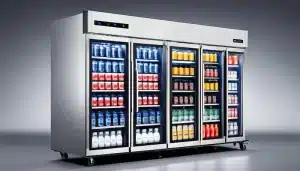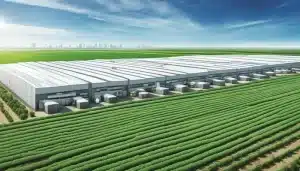Welcome to our article on efficient cold storage warehouse solutions, where we explore how businesses in the Philippines can optimize their storage facilities for temperature-sensitive goods. Cold storage is crucial for preserving the quality and extending the shelf life of perishable products. In the tropical climate of the Philippines, where unique challenges arise, efficient cold storage solutions are particularly essential.
By investing in advanced technologies, optimizing operations, and implementing sustainable practices, businesses can enhance the efficiency of their cold storage facilities and improve overall productivity. In this article, we will delve into the various aspects of cold storage warehousing, including innovative technologies, optimizing operations, design and construction considerations, challenges and solutions, and specialized storage for agricultural and hazardous materials.
Throughout this article, we will provide valuable insights and actionable recommendations to help you make informed decisions about your cold storage warehouse solutions. Whether you are in the agriculture, food processing, pharmaceuticals, or logistics industry, our aim is to guide you in creating efficient and effective cold storage facilities that meet your specific needs.
Join us as we explore the world of cold storage and discover how you can maximize the potential of your cold storage warehouse solutions in the Philippines.
Table of Contents

Overview of Cold Storage Warehousing in the Philippines
Cold storage warehousing plays a significant role in the Philippines due to its tropical climate. The high temperatures and humidity levels in the country make it essential to preserve perishable goods and prevent spoilage. Cold storage facilities ensure that food products, pharmaceuticals, and chemicals are stored at the appropriate temperatures to maintain their integrity.
In addition, key industries such as agriculture, food processing, pharmaceuticals, and logistics heavily rely on cold storage to meet the demand for temperature-controlled storage and distribution.
The Philippines’ agricultural sector depends on cold storage to preserve the freshness and quality of perishable produce. The food processing industry requires temperature-controlled storage to ensure food safety and prevent spoilage. Pharmaceuticals and chemicals also require specific storage conditions to maintain their efficacy and reduce the risk of contamination.
Moreover, the logistics industry relies on cold storage warehousing to ensure the efficient storage and distribution of temperature-sensitive products. By providing the necessary infrastructure and technologies, cold storage facilities support the smooth flow of goods throughout the supply chain, ensuring that products reach consumers in optimum condition.
Innovative Technologies in Cold Storage
To enhance the efficiency and effectiveness of cold storage warehouses, innovative technologies are being implemented. Advanced refrigeration systems, such as blast freezers and cold rooms, ensure precise temperature control and rapid cooling.
Automation and the Internet of Things (IoT) play a crucial role in temperature monitoring and control, allowing for real-time data analysis and adjustments. IoT sensors gather data on temperature, humidity, and other environmental factors, enabling intelligent temperature management and preventing temperature fluctuations that can affect product integrity.
By optimizing security, automated access controls can streamline operations and improve safety. For instance, the implementation of automatic security gates enhances facility protection while allowing controlled entry and exits essential in managing the cold chain effectively.
Automated storage and retrieval systems optimize space utilization and reduce labor costs. These systems utilize state-of-the-art robotics and automation technologies to efficiently store and retrieve products, minimizing human intervention and streamlining operations.
The integration of IoT and automation in cold storage warehouses enables data-driven decision-making and enhances overall operational efficiency. Real-time monitoring, predictive analytics, and remote control capabilities allow for proactive maintenance and troubleshooting, reducing downtime and improving productivity.
By embracing these innovative technologies, cold storage warehouses in the Philippines can achieve enhanced performance, improved product quality, and increased cost efficiency, ultimately providing businesses with a competitive edge in the market.
To find out more about how technology can help with warehouse storage, you can consider a price calculation to see if HashMicro’s warehouse software is the right choice.
Optimizing Operations in a Cold Storage Warehouse
Efficient operations are vital for maximizing the productivity of a cold storage warehouse. To achieve this, several key areas need to be addressed:
- Proper inventory management: Accurate inventory tracking and management systems are essential to ensure that products are readily available and avoid stockouts or excess inventory.
- Efficient order picking and packing processes: Streamlined processes for order picking and packing reduce errors and improve the speed and accuracy of order fulfillment.
- Streamlined logistics and transportation: Coordinating transportation schedules, optimizing routes, and ensuring timely delivery of goods are crucial to minimize delays and keep operations running smoothly.
- Effective staff training: Well-trained staff who understand the unique requirements of handling temperature-sensitive products are essential for maintaining product quality and ensuring safety protocols are followed.
To further optimize operations, implementing a robust Top warehouse platforms (WMS) can greatly enhance efficiency. Hashmicro’s WMS is a state-of-the-art solution that automates and streamlines workflows, improving inventory accuracy and reducing manual errors. With real-time data analytics and monitoring, businesses can identify bottlenecks, adjust processes, and optimize operational workflows for increased productivity.
By leveraging advanced technologies and optimizing operations, businesses can enhance their cold storage warehouse’s efficiency, delivering better customer service, reducing costs, and maximizing profitability.
Design and Construction of Efficient Cold Storage Facilities
The design and construction of efficient cold storage facilities are critical to ensuring optimal storage conditions for temperature-sensitive goods. By incorporating key elements such as insulation, energy efficiency, and space optimization, businesses can maximize the effectiveness and cost-effectiveness of their cold storage operations.
Effective insulation plays a crucial role in maintaining stable temperatures and reducing heat transfer within the facility. Insulated walls, roofs, and floors, along with high-quality doors and seals, help prevent heat ingress and energy loss. This insulation not only ensures consistent temperature control but also contributes to energy savings and overall cost reduction.
Energy efficiency is another vital aspect of designing and constructing efficient cold storage facilities. Implementing energy-efficient refrigeration systems and LED lighting can significantly contribute to reducing energy consumption and operating costs. These energy-saving measures help businesses operate in a more environmentally sustainable manner while staying economically competitive.
Space optimization is essential for maximizing storage capacity and ensuring efficient material handling. Smart layout planning and the utilization of vertical space through mezzanines and high-density storage systems enable businesses to make the most of their available space. By optimizing storage capacity, businesses can store a larger quantity of products while maintaining easy access and streamlined operations.
Overall, the design and construction of efficient cold storage facilities involve a combination of insulation, energy efficiency, and space optimization strategies. By implementing these elements, businesses can create a highly efficient and cost-effective cold storage environment, ultimately enhancing the quality and longevity of their temperature-sensitive products.
Challenges and Solutions in Cold Storage Operations
Cold storage operations face several challenges that need to be addressed for efficient functioning. One of the key challenges is maintaining consistent temperatures throughout the facility to prevent product spoilage. Temperature fluctuations can significantly impact the quality and integrity of perishable goods. To address this challenge, it is crucial to implement temperature monitoring systems that provide real-time data on temperature variations. Regular maintenance of refrigeration equipment is also essential to ensure optimal performance and minimize the risk of temperature fluctuations. Moreover, providing proper training to staff on temperature control protocols can help prevent human errors that may lead to temperature inconsistencies.
Another significant challenge in cold storage operations is the high operational costs associated with energy expenses and labor costs. Cold storage facilities require substantial amounts of energy to maintain the desired temperature levels. Implementing energy-efficient practices can help mitigate these costs. This could include investing in advanced refrigeration systems that consume less energy or utilizing renewable energy sources such as solar power. Optimizing workforce management through efficient scheduling and training programs can also help reduce labor costs.
To address the challenges mentioned above, businesses can also leverage advanced technologies designed specifically for cold storage operations. The Internet of Things (IoT) can enable real-time monitoring and control of temperature conditions, allowing for quick response and adjustments as needed. Additionally, automation technologies can streamline processes, minimize human intervention, and improve efficiency.
By addressing these challenges and implementing appropriate solutions, businesses can establish and maintain efficient cold storage operations that ensure product quality, reduce operational costs, and enhance overall profitability.
Fulfilling Agricultural Storage Needs with Advanced Cold Warehouses
The agricultural sector in the Philippines requires specialized cold storage solutions to preserve perishable produce and extend their shelf life. Advanced cold warehouses with controlled temperature and humidity levels ensure optimal storage conditions for agricultural products, including fruits, vegetables, and flowers. These facilities employ technologies such as humidity control systems, ethylene scrubbers, and modified atmosphere packaging to protect the quality and freshness of agricultural products. By investing in advanced cold storage solutions, farmers and suppliers can minimize post-harvest losses and meet market demand.
Cold Storage Warehouse Solutions for Hazardous Material
Cold storage warehouses not only meet the storage requirements of perishable goods but also cater to the needs of hazardous materials. This includes chemicals, pharmaceuticals, and biological samples that require specialized storage conditions to ensure safety and prevent contamination.
Cold storage solutions for hazardous materials incorporate various measures to maintain the integrity of the stored substances. Explosion-proof storage units are designed to minimize the risk of fire and explosions, providing a secure environment for volatile materials. Controlled ventilation systems ensure proper airflow while preventing cross-contamination.
Strict adherence to safety protocols is crucial in cold storage warehouses for hazardous materials. Staff members undergo specialized training to handle and store these substances safely. Additionally, advanced security and monitoring systems are implemented to maintain strict control over access and prevent unauthorized handling of hazardous materials. This ensures that the hazardous materials are secured and protected at all times.
Also read: Optimize Storage with a Temporary Warehouse in the Philippines
Sustainability Practices in Cold Storage Warehousing
Cold storage warehousing plays a significant role in the Philippines, and embracing sustainability practices can help minimize environmental impact and reduce operating costs. One important aspect of sustainability is implementing green energy solutions. By incorporating solar panels or energy-efficient refrigeration systems, you can significantly reduce reliance on traditional energy sources, lower carbon emissions, and promote a greener environment.
Another crucial element in sustainable cold storage warehousing is waste reduction. Developing recycling programs and adopting efficient packaging practices can help minimize waste generation and promote sustainable operations. By reducing waste, you not only contribute to environmental preservation but also improve overall efficiency and cost-effectiveness.
In addition to energy and waste management, implementing eco-friendly practices within your cold storage facility is essential. Consider incorporating rainwater harvesting systems to conserve water resources. This sustainable practice can help reduce dependence on external water sources and contribute to your facility’s eco-efficiency. Moreover, opting for energy-efficient LED lighting and obtaining green building certifications can further enhance the sustainability of your cold storage facility.


























